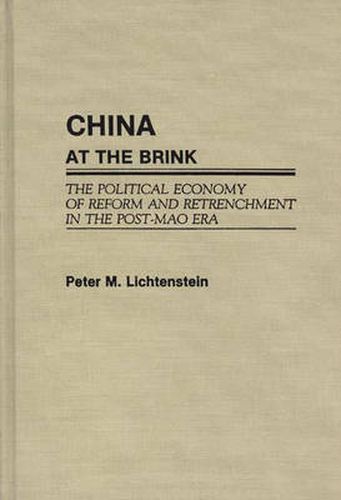Readings Newsletter
Become a Readings Member to make your shopping experience even easier.
Sign in or sign up for free!
You’re not far away from qualifying for FREE standard shipping within Australia
You’ve qualified for FREE standard shipping within Australia
The cart is loading…






As a Western economist studying and working abroad, Peter M. Lichtenstein witnessed first-hand China’s tumultuous cycle of reform and retrenchment in the 1980s. From the early euphoric stage to the last and most brutal episode, Lichtenstein’s book describes and explains the economics behind this cycle and ties together the economic, political and cultural aspects of the reform era. The book also chronicles the achievements, problems events and political controversies that led up to the Tiananmen Square debacle and the subsequent retrenchment away from the broad goals of reform. Organized chronologically, this work begins by detailing the reasons for the economic reform movement upon the death of Mao in 1976. In the mid-1980s those reforms began to encounter serious difficulties - Lichtenstein explains what these difficulties were and why they arose. He also describes how, in the summer of 1988, the conservative hardliners were able to regain political power from the reformers, setting the stage for what would happen eight months later in Tiananmen Square. Following this is an analysis of the development of the basic positions of the Chinese left and right, and Lichtenstein’s first-hand observations of the retrenchment following Tainanmen. Concluding with a retrospective look at the reforms and retrenchment, this work should be of interest to professors and students of political science, international relations, economics, contemporary Asian history and China in particular.
$9.00 standard shipping within Australia
FREE standard shipping within Australia for orders over $100.00
Express & International shipping calculated at checkout
As a Western economist studying and working abroad, Peter M. Lichtenstein witnessed first-hand China’s tumultuous cycle of reform and retrenchment in the 1980s. From the early euphoric stage to the last and most brutal episode, Lichtenstein’s book describes and explains the economics behind this cycle and ties together the economic, political and cultural aspects of the reform era. The book also chronicles the achievements, problems events and political controversies that led up to the Tiananmen Square debacle and the subsequent retrenchment away from the broad goals of reform. Organized chronologically, this work begins by detailing the reasons for the economic reform movement upon the death of Mao in 1976. In the mid-1980s those reforms began to encounter serious difficulties - Lichtenstein explains what these difficulties were and why they arose. He also describes how, in the summer of 1988, the conservative hardliners were able to regain political power from the reformers, setting the stage for what would happen eight months later in Tiananmen Square. Following this is an analysis of the development of the basic positions of the Chinese left and right, and Lichtenstein’s first-hand observations of the retrenchment following Tainanmen. Concluding with a retrospective look at the reforms and retrenchment, this work should be of interest to professors and students of political science, international relations, economics, contemporary Asian history and China in particular.